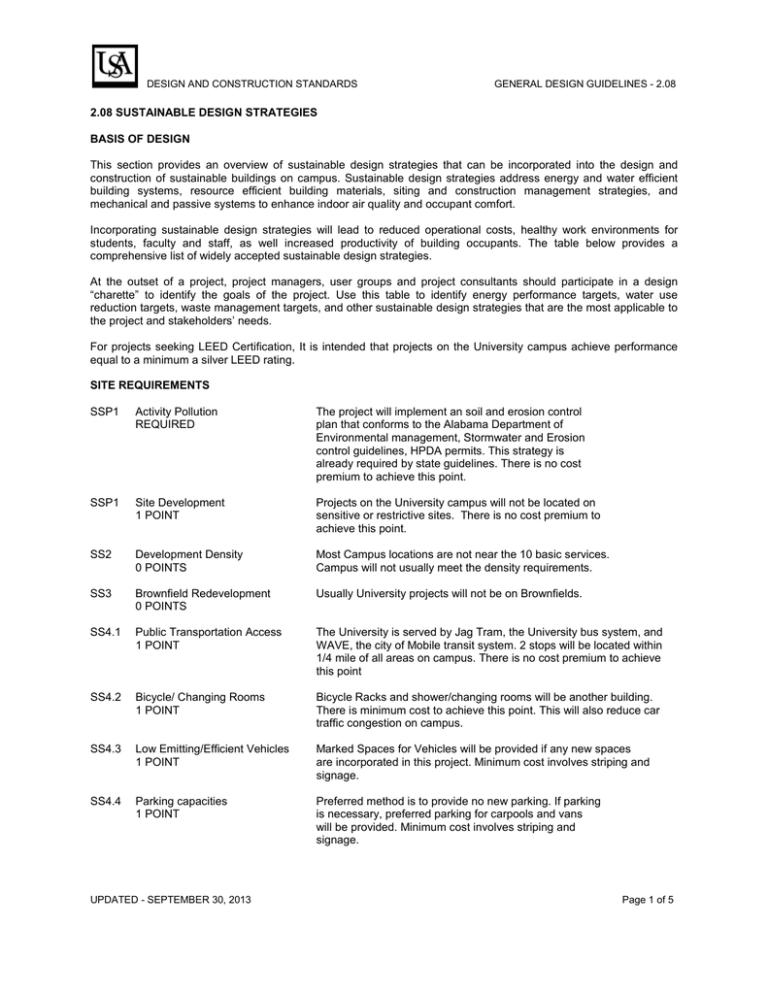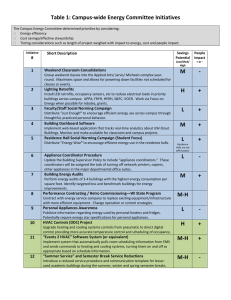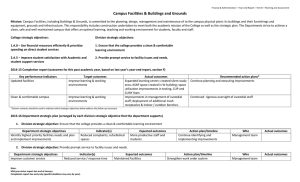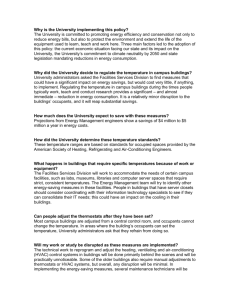Document 11171639
advertisement

DESIGN AND CONSTRUCTION STANDARDS GENERAL DESIGN GUIDELINES - 2.08 2.08 SUSTAINABLE DESIGN STRATEGIES BASIS OF DESIGN This section provides an overview of sustainable design strategies that can be incorporated into the design and construction of sustainable buildings on campus. Sustainable design strategies address energy and water efficient building systems, resource efficient building materials, siting and construction management strategies, and mechanical and passive systems to enhance indoor air quality and occupant comfort. Incorporating sustainable design strategies will lead to reduced operational costs, healthy work environments for students, faculty and staff, as well increased productivity of building occupants. The table below provides a comprehensive list of widely accepted sustainable design strategies. At the outset of a project, project managers, user groups and project consultants should participate in a design “charette” to identify the goals of the project. Use this table to identify energy performance targets, water use reduction targets, waste management targets, and other sustainable design strategies that are the most applicable to the project and stakeholders’ needs. For projects seeking LEED Certification, It is intended that projects on the University campus achieve performance equal to a minimum a silver LEED rating. SITE REQUIREMENTS SSP1 Activity Pollution REQUIRED The project will implement an soil and erosion control plan that conforms to the Alabama Department of Environmental management, Stormwater and Erosion control guidelines, HPDA permits. This strategy is already required by state guidelines. There is no cost premium to achieve this point. SSP1 Site Development 1 POINT Projects on the University campus will not be located on sensitive or restrictive sites. There is no cost premium to achieve this point. SS2 Development Density 0 POINTS Most Campus locations are not near the 10 basic services. Campus will not usually meet the density requirements. SS3 Brownfield Redevelopment 0 POINTS Usually University projects will not be on Brownfields. SS4.1 Public Transportation Access 1 POINT The University is served by Jag Tram, the University bus system, and WAVE, the city of Mobile transit system. 2 stops will be located within 1/4 mile of all areas on campus. There is no cost premium to achieve this point SS4.2 Bicycle/ Changing Rooms 1 POINT Bicycle Racks and shower/changing rooms will be another building. There is minimum cost to achieve this point. This will also reduce car traffic congestion on campus. SS4.3 Low Emitting/Efficient Vehicles 1 POINT Marked Spaces for Vehicles will be provided if any new spaces are incorporated in this project. Minimum cost involves striping and signage. SS4.4 Parking capacities 1 POINT Preferred method is to provide no new parking. If parking is necessary, preferred parking for carpools and vans will be provided. Minimum cost involves striping and signage. UPDATED - SEPTEMBER 30, 2013 Page 1 of 5 DESIGN AND CONSTRUCTION STANDARDS GENERAL DESIGN GUIDELINES - 2.08 SS5.1 Reduced site disturbance 1 POINT Natural areas of campus will be preserved. Damaged areas will be restored by choosing plants native to the area. Minimum additional cost involves selecting indigenous plantings. SS5.2 Maximize open space 1 POINT The campus master plan will provide permanent open space around all campus buildings. New buildings will be designed with minimum footprints to minimize additional site disturbance. SS6.1 Quantity - Stormwater 1 POINT Campus storm water will be discharged either to the USA owned and maintained Retention Lake for water shedding to the North before being discharged into the stream channel, or along Old Shell road for water shedding to the south. There is no cost premium to achieve this point. SS6.2 Quality - Stormwater 0 POINTS The University is not currently treating storm water. SS7.1 Heat Island -Non roof 1 POINT All campus projects will meet the required values for hardscaping by sufficient shading, paving materials with compliant solar reflectance, and open grid paving where practical. There is no cost premium to achieve this point. SS7.2 Heat Island - Roof 1 POINT Roof material on all campus buildings will meet required SRI Values. There is no cost premium to achieve this point. SS8 Light Pollution 1 POINT All exterior and interior light fixtures will be designed to meet dark sky requirements. Off site lighting and night sky pollution will be minimized. WATER EFFICIENCY WEP 20% Water Use Reduction REQUIRED Buildings will reduce potable water use by 20%, using high efficiency fixtures. WE1.1 50% Irrigation reduction 1 POINT Buildings will reduce irrigation use by 50%, by using limited planting with drought tolerant plants capable of surviving on natural rain fall. WE1.2 100% Irrigation reduction 1 POINT Buildings will reduce irrigation use by 100%, by using limited planting with drought tolerant plants capable of surviving on natural rain fall. WE2 At this time the University does not use grey water or noflush systems. Innovative Wastewater 0 POINTS WE3.1 30% Water Use Reduction 1 POINT Buildings will reduce potable water use by 30%, using high efficiency fixtures. WE3.2 35% Water Use Reduction 1 POINT Buildings will reduce potable water use by 35%, using high efficiency fixtures. WE3.2 40% Water Use Reduction 1 POINT Buildings will reduce potable water use by 40%, using high efficiency fixtures. UPDATED - SEPTEMBER 30, 2013 Page 2 of 5 DESIGN AND CONSTRUCTION STANDARDS GENERAL DESIGN GUIDELINES - 2.08 ENERGY AND ATMOSPHERE EAP1 Fundamental Commissioning REQUIRED This is a required strategy. EAP2 Minimum Energy Performance REQUIRED Buildings will meet minimum standards for energy efficiency. EAP3 Fundamental Refrigeration REQUIRED The university will use compliant refrigerant at the Central Plant. EA1 Optimize energy 7 POINTS Achieve 24.5% above baseline goal for energy performance. EA2 On site Renewable 0 POINTS The University in not currently using renewable energy systems. These systems would be simple to implement but the payback time is too great at the moment. EA3 Enhanced commissioning 1 POINT Owner will contract for enhanced commissioning services. EA4 Enhanced refrigeration 1 POINT All new buildings will be conditioned by the university central plants. Compliant refrigerants will be used in these facilities. EA5 Measurement/Verification 1 POINT A measurement and verification plan will be implemented. EA6 Green Power 0 POINTS Purchase off site renewable MATERIALS AND RESCOURCES MRP1 Recyclable collection REQUIRED All new buildings will provide an area to store and collect recyclables. MR1.1 55% - Building reuse 1 POINT POSSIBLE Structural elements, applicable to renovations only. MR1.1 75% - Building reuse 1 POINT POSSIBLE Structural elements, applicable to renovations only. MR1.1 95% - Building reuse 1 POINT POSSIBLE 55% - Building reuse 1 POINT POSSIBLE Structural elements, applicable to renovations only. MR1.2 Non-Structural elements, applicable to renovations only. MR2.1 50% Waste management 1 POINT A waste management program will be implemented. MR2.2 75% Waste management 1 POINT A waste management program will be implemented MR3.1 5% Material reuse 0 POINTS May not be possible on a majority of buildings. MR3.2 10% Material reuse May not be possible on a majority of buildings UPDATED - SEPTEMBER 30, 2013 Page 3 of 5 DESIGN AND CONSTRUCTION STANDARDS GENERAL DESIGN GUIDELINES - 2.08 0 POINTS MR4.1 10% Recycled content 1 POINT 10% recycled content will be used in the materials for this building MR4.2 20% Recycled content 1 POINT 20% recycled content will be used in the materials for this building MR5.1 10% Regional materials 1 POINT 10% regional content will be used in the materials for this building MR5.2 20% Regional materials 1 POINT 20% regional content will be used in the materials for this building MR6 Renewable materials 0 POINTS May not be possible on a majority of buildings. MR7 Certified wood 0 POINTS May not be possible on a majority of buildings. INDOOR ENVIRONMENTAL QUALITY IEQ-P1 Minimum Indoor Air REQUIRED Required prerequisite. IEQ-P2 Tobacco Smoke Control REQUIRED Required prerequisite. EQ1 Outdoor air delivery 0 POINTS Humid gulf coast location makes this point readily unachievable. EQ2 Increased Ventilation 1 POINT Air ventilation will be increased by 30% EQ3.1 IAQ Plan-construction 1 POINT Project will have an indoor air quality plan during construction. EQ3.2 IAQ Plan - Occupancy 1 POINT Project will have an indoor air quality plan during occupancy. EQ4.1 Low emitting - adhesives 1 POINT Adhesives will meet South Coast Air Quality Management District requirements. EQ4.2 Low emitting - paints 1 POINT Paints and coatings will meet Green Seal Standard GS11. EQ4.3 Low emitting - carpet 1 POINT Carpet will meet Green Label Program Requirements. EQ4.4 Low emitting - wood 1 POINT EQ5 Indoor chemical 1 POINT Indoor pollutants will be minimized. EQ6.1 Control - lighting 1 POINT 90% of occupants will have individual control. EQ6.2 Control - thermal 50% of occupants will have individual control. UPDATED - SEPTEMBER 30, 2013 Page 4 of 5 DESIGN AND CONSTRUCTION STANDARDS GENERAL DESIGN GUIDELINES - 2.08 1 POINT EQ7.1 Thermal comfort-design 1 POINT Building will meet ASHRAE 55-2004. EQ7.2 Thermal comfort-verification 1 POINT Thermal comfort survey will be performed. EQ8.1 75% Daylight 1 POINT 75% of building occupants will have natural daylight. EQ8.2 90% Views 1 POINT 90% of building occupants will have exterior views. INNOVATION AND DESIGN PROCESS ID1 LEED Accredited Professional 1 POINT The University will engage a LEED consultant on all projects. REGIONAL PRIORITY CREDITS RP1 UPDATED - SEPTEMBER 30, 2013 To be determined. Page 5 of 5






